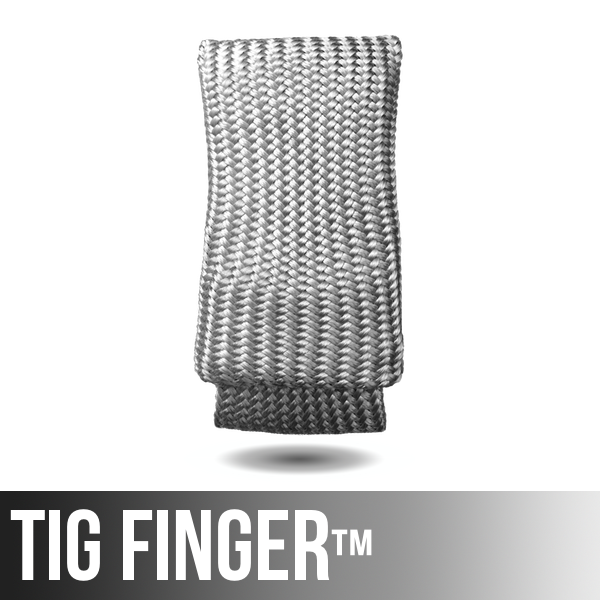Video Transcript
TIG Welding Steel Cube
HToday, I’m doing a little TIG welding. I’m gonna weld up a little three-inch square cube, outside corner joints. It’s quarter-inch thick metal, three inches by three inches. So it takes six pieces to do that with. That gives me plenty of welds to experiment with different filler wire types, sizes, pulse settings. Let’s do it.
All right. This is cold rolled steel. I’m gonna clean it anyway. Using a little Walter flap disk here. I’m gonna clean these edges. And actually I wound up buffing the whole thing everywhere, just because the cleaner, the better when it comes to TIG welding.
Using a piece of aluminum angle to kind of hold the pieces at a 90-degree angle, I got some tacks on there without even using filler. And it’s going to come in handy, too, for getting the extra piece on there to turn this thing into a cube.
And I messed up, so I pulled one loose. Only had one tack on it. I’ll massage it a little bit. Make sure there’s no gaps. Make sure everything is kind of at 90 degrees. And then that’s much better. Putting small tacks on helps for that reason, if you need to pull something loose.
And then on the corners, I added a little bit of filler here and there just to make sure nothing popped loose while I was welding it. Because I’ll get in a hurry like always, and I’ll put a lot of heat in this thing. And if I just have one little, tiny tack here and there, it won’t be enough.
I’m using this Furick #12 ceramic, now available at Weldmonger.com. It works really good.
I got the machine set to 130 amps. I’m probably closer to 110. I’m not using full pedal, for the most part. And I’m trying to hold a nice, tight arc and use just enough heat to run a small bead in there. And the reason I’m running a small bead is I’m going to fill that … fill that in there with a second pass later on.
So for right now, I’m just sewing it up. First pass there done with the ER309 rod, just for kicks. Probably not a good habit to get into, welding steel with 309 all the time, but for a cube, no problem.
309 is designed to weld carbon to stainless steel, works great for that. But when you weld carbon steel with it, depending on how much you dilute, how much carbon steel you melt in it, you can kind of get inconsistent results. And for anything critical, you don’t want inconsistent results.
Let’s take a quick look at this right here. People ask a lot, “How do you hold a tight arc without just crapping up the electrode all the time?” If you pay close attention, I’m pulling the arc link back just a little bit while I dip the rod. Just a little bit. It’s kind of subtle, but that keeps me from having to sharpen a lot of electrodes and still hold the tight arc.
Here, I’m trying to use … I’m trying to get by with just enough heat to flow that pole. And I’m stepping out just a little bit further in between dips or dabs. And you can see the heat tint is much less than the previous weld. And your heat tint, even though that discoloration is not 100% indicator of heat affected zone, it is sort of a way of gauging it. So the color is better on that one, a little less heat tint. Learn something there.
Here, I using a smaller diameter ER70 rod. And it’s putting quite a bit of heat in there. But that is not because of the rod or anything other than I kind of got in a hurry. I didn’t stop and let it cool, so the piece was already really hot. That makes a big difference on discoloration and size of your heat affected zone.
I’m going to try a little pulse setting now. And I’m going to step up the diameter of the wire to a 3/32 diameter. And when you use pulse, you have to use more current, because it’s alternating between a high current and a low current.
So I’m using one and a half pulses a second here. I got the machine set to 200. I won’t quite need all that, but I’ll be using a foot pedal and I’ll just use it as needed. And that’s probably about three-quarter, maybe just a little bit more than three-quarters on the foot pedal.
So you still have to hold a nice, tight arc and keep a little pressure on that filler rod to keep it from coming loose from the molten puddle, but it works out pretty good.
If you can keep your speed about the same and keep that wire in the puddle, it does make for a pretty decent looking bead.
And when this thing cools off enough that I can handle it a little bit better, I will take a wire wheel, buff everything. All those welds, I’ll buff them down nice and shiny. And hopefully, that silicon bronze wire will flow in there nice and good.
Well, that’s all I got time for today. So I want to do a part two on this and I’m gonna fill the rest of those outside corners in with silicon bronze filler wire, using a nice little weave pass.
And I’ll see if that’ll buff off nice and shiny. See if we can make this cube look like something special. Heh, be the first time I ever did that because I’m not much of an artist. If not a paperweight for the desk, it’ll be a prop to just rest my palm on to weld other cubes or whatever comes along.
Thanks for watching. See you next time.
I would appreciate it if you would visit my online store at Weldmonger.com. That is how I support these videos.







December 6, 2017 at 10:55 AM
This is more of a “art” type of question, but what about using two , three..etc. rods to produce a basket weave pattern? Have you ever done this?